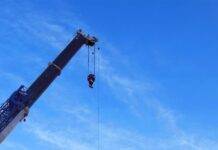
Safety Factor of Webbing Sling
The safety of any lifting equipment, including webbing slings, is paramount in industrial operations. These flexible and durable tools are essential in various lifting tasks across industries. However, ensuring their safety factors are met is crucial to prevent accidents and ensure optimal performance.
Introduction to Webbing Slings
Webbing slings are versatile tools used for lifting heavy loads in industries like construction, shipping, and manufacturing. These slings are crafted from woven polyester, nylon, or polypropylene materials, providing strength and flexibility for lifting applications.
Understanding Safety Factors
What are Safety Factors?
Safety factors refer to the ratio of the breaking strength of a material to the maximum working load applied. It’s a critical measure determining the safety margin of a webbing sling.
Importance of Safety Factors in Webbing Slings
In lifting operations, safety factors ensure that the webbing slings can handle loads safely without the risk of failure or breakage, offering a cushion against unforeseen stresses.
Factors Influencing Safety in Webbing Slings
Material Quality
The quality of materials used in constructing webbing slings significantly impacts their safety. High-grade materials ensure durability and load-bearing capacity.
Design and Construction
The structural design and construction of webbing slings play a pivotal role in their safety. Well-constructed slings with reinforced stitching and proper assembly enhance their reliability.
Safe Usage and Maintenance
Proper handling, storage, and regular maintenance contribute to the safety and longevity of webbing slings. Adhering to manufacturer guidelines is crucial.
Calculating Safety Factor in Webbing Slings
The safety factor can be calculated by dividing the breaking strength of the sling by the maximum expected working load. For instance, a sling with a breaking strength of 10,000 lbs and a working load of 2,000 lbs would have a safety factor of 5.
The safety factor of a webbing sling refers to the ratio between the breaking strength of the sling and the maximum working load it's designed to handle. It's a critical factor in ensuring safety during lifting operations. Typically, the safety factor for webbing slings ranges from 5:1 to 8:1, meaning the breaking strength of the sling is five to eight times higher than the expected maximum load it will bear. This allows a margin of safety to account for potential dynamic forces, wear and tear, and other unexpected stressors during use.Regulatory Standards and Safety Guidelines
Adherence to OSHA regulations and European standards is essential for ensuring compliance and safety. Employers must follow best practices to meet safety guidelines.
Common Risks and Hazards Associated
Overloading, abrasion, chemical exposure, and improper usage pose risks to webbing slings. Understanding and mitigating these risks are imperative for safety.
Inspection and Maintenance Protocols
Regular inspection and maintenance routines are crucial. Regular checks for wear, tear, and damage ensure early detection and prevent accidents.
Training and Education for Safe Use
Training programs and certification courses educate users on proper handling and safety protocols, reducing the risk of accidents.
Comparative Analysis: Webbing vs. Other Lifting Solutions
Webbing slings offer advantages like flexibility and ease of use. Comparatively, chain slings and wire rope slings have different strengths and limitations, highlighting the importance of selecting the right tool for specific tasks.
Case Studies Highlighting Safety Successes
Real-life examples demonstrate how adherence to safety protocols and regulations significantly reduces accidents and enhances workplace safety.
Addressing Myths and Misconceptions
Debunking myths and clarifying misconceptions about webbing slings ensures accurate knowledge and safe usage in industries.
Future Innovations in Webbing Sling Safety
Advancements in material technology and enhanced safety features promise even safer and more efficient webbing slings in the future.
Consumer Tips for Selecting Safe Webbing Slings
Understanding quality indicators and choosing the right type of sling based on specific requirements enhances safety and performance.
Conclusion
Ensuring the safety factor of webbing slings is fundamental in preventing accidents and ensuring efficient lifting operations. Adherence to safety guidelines, proper maintenance, and continuous education are key in utilizing these indispensable tools safely.
How To Calculate Crane Capacity According to Load
Web Sling Capacity Calculation
Unique FAQs
1. What are the primary materials used in webbing slings?
Webbing slings are commonly crafted from materials like polyester, nylon, and polypropylene. These materials offer a balance of strength, flexibility, and durability, making them suitable for various lifting tasks across industries.
2. How often should webbing slings undergo inspection?
Regular inspection is crucial to ensure the safety and integrity of webbing slings. Typically, inspections should be conducted before each use, and periodic thorough inspections (every 3 to 12 months) are recommended based on the frequency and nature of usage.
3. Are there specific regulations for different industries regarding the use of webbing slings?
Yes, different industries may have specific regulations or standards regarding the use of lifting equipment, including webbing slings. It’s essential to comply with relevant regulatory guidelines set forth by organizations such as OSHA (Occupational Safety and Health Administration) or industry-specific authorities.
4. Can a damaged webbing sling be repaired, or is replacement necessary?
The general recommendation is to replace damaged webbing slings rather than attempting repairs. Damages such as cuts, tears, or fraying compromise the integrity of the sling, and attempting repairs may not restore its original strength and safety.
5. What advancements are expected in the future for enhancing webbing sling safety?
Future advancements in webbing sling safety are likely to focus on material innovations, such as the development of stronger and more resistant fibers. Additionally, there may be advancements in smart technology integration for real-time monitoring of sling conditions, enhancing safety and predictive maintenance capabilities.





















